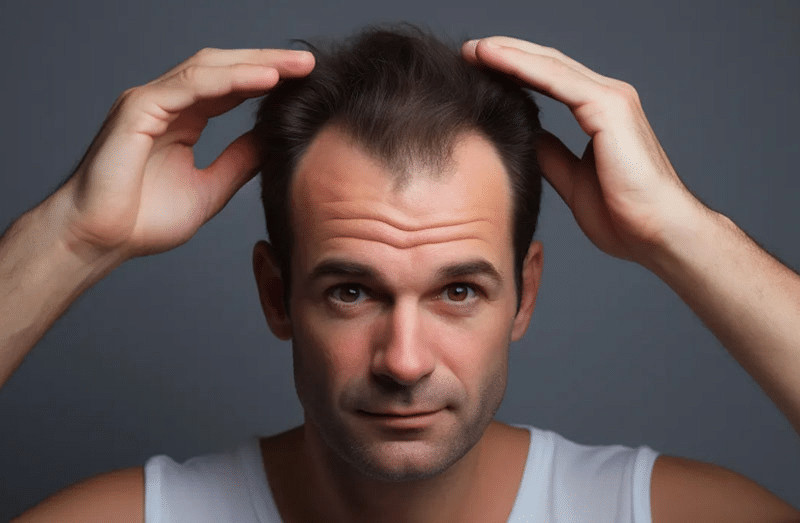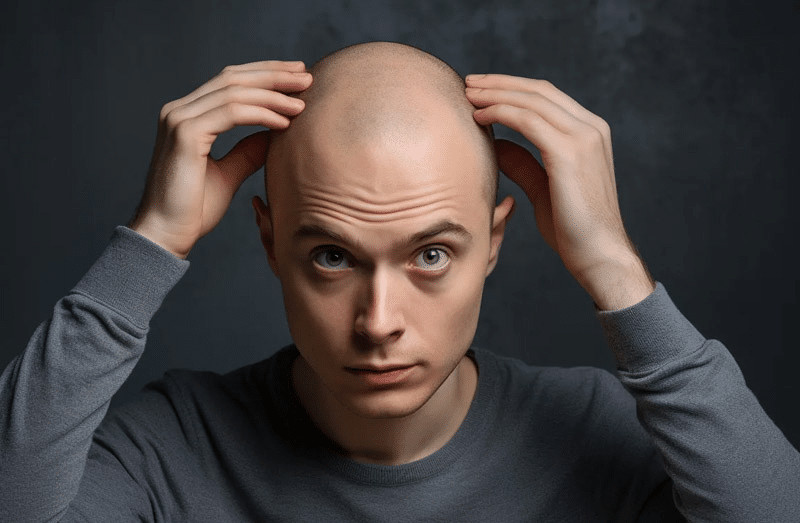The Hamilton-Norwood Scale is a commonly used classification system to determine the stage and severity of sparse hair remaining baldness. This scale provides a visual representation of the different degrees of hairloss, ranging from minimal to severe.
By identifying which hair class you fall into according to this scale, you can better understand the extent of your stage of hair loss and determine the best course of action for hair restoration.
In this article, we’ll delve deeper into the Hamilton-Norwood Scale and provide additional information on what to do if you are experiencing hair loss and in need of hair follicles loss treatments.
What is the Norwood-Hamilton scale?

The Norwood-Hamilton scale, also known as the Hamilton-Norwood Scale, is a commonly used classification system to determine the stage and severity of male pattern baldness. It was first developed in the 1950s by Dr. James Hamilton and later revised by Dr. O’Tar Norwood in the 1970s.
This scale provides a visual representation of the different degrees of hair loss, with seven stages ranging from minimal to severe. Stage 1 is considered normal hair growth with no signs of balding, while stage 7 represents extensive hair loss across the entire scalp.
What Should I Do if I’m Losing Hair?

If you are experiencing hair loss, the first step is to consult a dermatologist or doctor who specializes in hair loss. They can examine your scalp and determine the cause of your hair loss. In some cases, underlying health issues may be contributing to hair loss, which should be addressed before considering any type of treatment.
Once the cause has been identified, you can discuss different hair restoration options with your doctor. These may include medications, laser therapy, or surgical procedures such as a hair transplant. It’s important to carefully consider all factors and make an informed decision before moving forward with any type of treatment.
The 7 stages of the Norwood-Hamilton scale

Here are the 7 stages of male pattern hairloss as described by the Norwood-Hamilton scale:
Stage One & Two:
While stages 1 and 2 may not seem like significant hair loss, it is important to address these stages early on. The earlier hair loss is treated, the better the chances of successful treatment and preserving existing hair. This can also help prevent further progression into more severe stages of male pattern baldness.
Early intervention can involve medication or low-level laser therapy to slow down hair loss and promote regrowth. Hair transplants may also be an option for those in stages 1 and 2, as it can help improve the fullness and symmetry of the hairline.
Stage Three Vertex:

Hair loss at the vertex is also known as a bald spot or thinning spot. It can affect both men and women and may be caused by a variety of factors including genetics, aging, and hormonal changes. In stage 3 of the Norwood-Hamilton scale, hair loss at the vertex becomes more pronounced and will require more grafts for hair transplant procedures.
It is important to address this stage of hair loss as soon as possible to prevent further thinning and balding. Treatment options may include topical medications, vitamins, and hair transplant procedures.
Stages 4-6:

These stages are considered moderate to extensive hair loss and may require a larger number of grafts during hair transplant procedures. Treatment options can include medications, laser therapy, and surgical procedures such as Follicular Unit Extraction (FUE) or Follicular Unit hair transplantation.
It is important for individuals in these stages of hair loss to consult with a trusted hair restoration specialist to discuss the best treatment options for their specific needs.
Stage 7 (Most Severe)

Stage 7 is the most severe stage of male pattern baldness. In this stage, there is a significant amount of hair loss across the entire scalp, leaving only sparse hair around the sides and back. The frontal and top areas of the head are almost entirely bald.
Treatment options for stage 7 may include surgical procedures such as FUE or FUT, depending on the individual’s hair type and preferences. Non-surgical options may also be considered, such as scalp micropigmentation or a hairpiece.
At what stage is it possible to undertake a hair transplant?

Hair transplant procedures can be performed at any stage of the Norwood-Hamilton scale, depending on the individual’s needs and preferences. After all, hair loss varies from person to person. In earlier stages of hair loss, fewer grafts may be needed to achieve desired results.
However, even in more advanced stages, hair transplants can still yield successful results. At Best Hair Transplant in Los Angeles, our team of experienced hair restoration specialists can help guide you through the process and determine the best course of action for your specific situation.
How do I know if I’m on the Norwood Scale?

If you are experiencing visible hair loss, it’s important to consult with a dermatologist or doctor who specializes in hair loss. They can assess your level of hair loss and determine which stage of the Norwood-Hamilton scale you fall into.
It’s also helpful to know the different stages and patterns of male pattern baldness so that you can better understand your own situation. By identifying your stage, you can then discuss treatment options with your doctor and make an informed decision on how to move forward.
How is male pattern baldness diagnosed?

Male pattern baldness is typically diagnosed based on a physical examination of the scalp and hair loss patterns. Doctors may also ask about family history, overall health, and any medications being taken. In some cases, a scalp biopsy may be performed to rule out other potential causes of hair loss.
The Norwood-Hamilton scale is another important tool used in discussing male pattern baldness. It allows doctors to accurately classify the stage and severity of hair loss, which can help determine the best course of hair loss treatments for each individual patient.
Tips for healthy hair growth

While hair loss and male pattern baldness can’t always be prevented, there are some steps you can take to promote healthy hair growth and avoid notable hair loss:
Maintain a balanced and nutritious diet rich in vitamins and minerals.
Avoid harsh styling techniques such as tight braids or ponytails that can cause traction alopecia.
Don’t overuse heat tools on your hair, such as blow dryers and straighteners.
Use hair products specifically designed for your hair type.
Avoid smoking and excessive alcohol consumption, which can harm hair follicles.
Consider using a low-level laser therapy device to stimulate hair growth.

Remember, early intervention is key when it comes to treating male pattern baldness. If you are experiencing hair loss, consult with a trusted doctor or hair restoration specialist to discuss your options and find the best course of treatment for you.
The takeaway
The Norwood-Hamilton scale is a widely used tool for classifying and understanding the stages of male pattern baldness. By knowing your stage, you can better understand your situation and discuss treatment options with your doctor.
It’s important to address hair loss early on, as it can lead to more severe hair loss stages of balding if left untreated. However, even in more advanced stages, there are still effective treatment options available.
With the help of a hair restoration specialist and proper care, you can promote healthy hair growth and regain confidence in your appearance. Don’t hesitate to seek professional advice and take control of your hair loss journey today.
SUFFERING FROM HAIR LOSS?

Hair loss can be a daunting and emotional experience for anyone, but it’s important to remember that you are not alone. Millions of men and women struggle with hair loss every year, and there is no shame in seeking help or exploring treatment options.
At Best Hair Transplant, we understand the impact that hair loss can have on self-confidence and overall well-being. That’s why we offer a variety of options for hair restoration and strive to make the process as affordable and comfortable as possible for our patients. Our hair transplant surgeon and hair restoration team is here to stop the spread of your bald area and ensure you don’t lose hair anymore.
FAQS

What is the Hamilton-Norwood Scale, and how does it help determine my hair class for male pattern hair loss?
The Hamilton Scale is a visual representation used by professionals to classify the stages of male pattern hair loss. It provides a standardized way to assess the extent and pattern of hair loss on the scalp.
What are the common signs of male pattern hair loss according to the Hamilton-Norwood Scale?
The common signs of male pattern hair loss, as indicated by the Hamilton-Norwood Scale, include a hairline recedes, hair separating or thinning at the temples, and the development of a mature hairline. These are often accompanied by sparse remaining hair in the crown and vertex areas.
Can I use the Hamilton-Norwood Scale to predict the progression of my hair loss pattern?
While the scale can provide a general idea of how one’s hair loss pattern may progress, it is important to note that everyone’s hair loss is unique and can vary from person to person. Additionally, the Hamilton-Norwood Scale only accounts for male pattern baldness and may not accurately predict the progression of other types of hair loss such as alopecia areata or scarring alopecia.
The scale does not take into consideration factors such as age, family history, medical conditions, or lifestyle habits that can also play a role in hair loss. It is always best to consult with a medical professional for personalized advice on predicting and managing hairloss.

